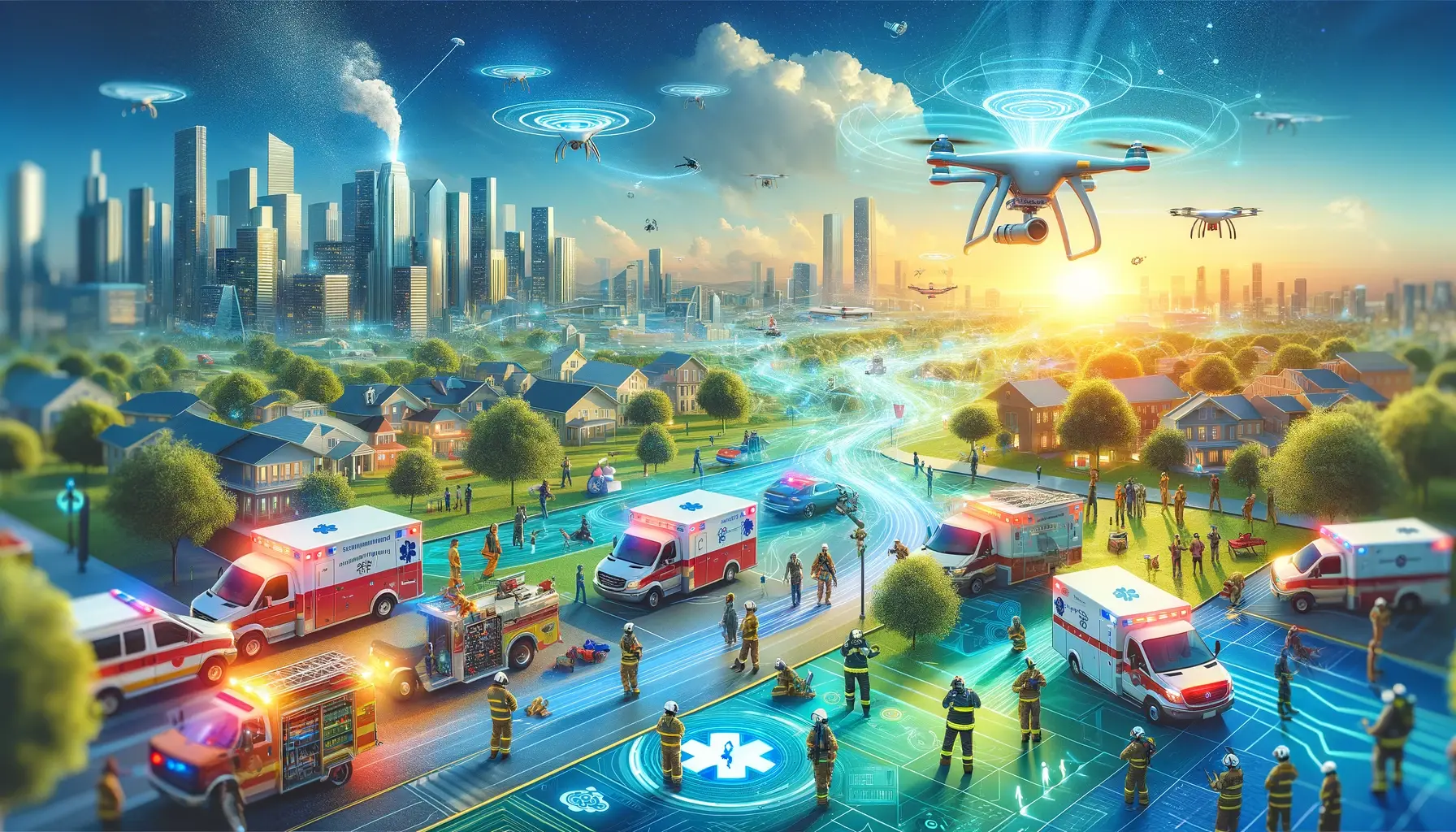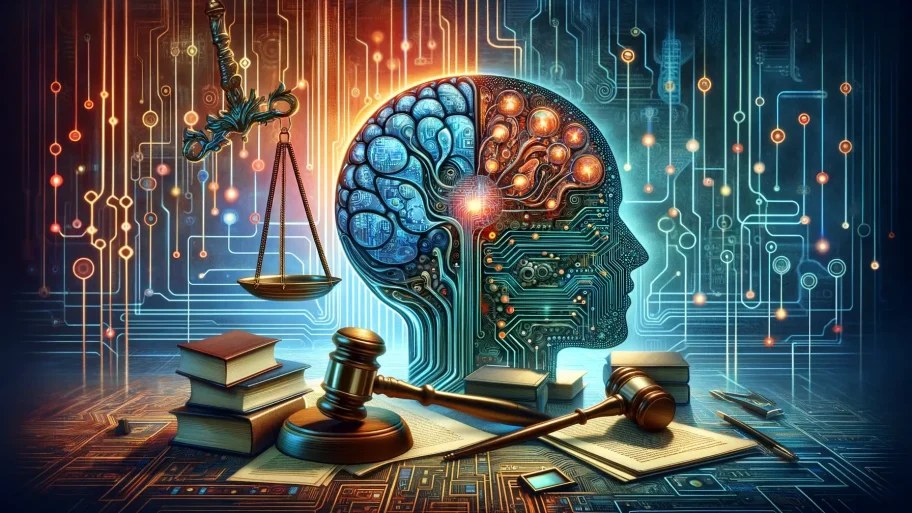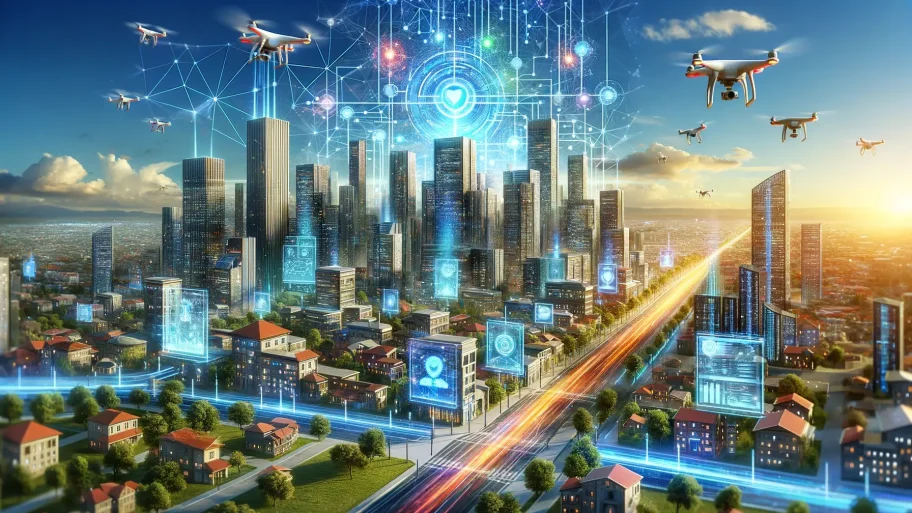Top 5 AI Use Cases In Public Safety Emergency Services
- By Matt

Attention Public Safety Professionals and Emergency Responders!
Equipment breakdowns, slow response times, and resource misallocation are not distant threats but imminent realities for those who fail to integrate AI into their emergency response strategies now.
In this article, we’ll reveal how AI can transform public safety and emergency response efficiency, helping you avoid these costly setbacks.
Key Takeaways
- Advanced Emergency Response Coordination improves communication and coordination during crises.
- Predictive Analytics for Emergency Management anticipates emergencies and allocates resources effectively.
- AI-Powered Dispatch Systems prioritize and dispatch services efficiently.
- Real-Time Data Analysis for Situational Awareness provides comprehensive views of emergencies.
- Incident Detection and Monitoring detects and monitors incidents using AI.
Use Case #5: AI-Powered Dispatch Systems
Starting our countdown at number 5 is the transformative application of AI in dispatch systems, a critical component for ensuring timely emergency response.
The Stress of Inefficient Dispatch
In emergencies, delays in dispatching services can lead to catastrophic outcomes. Traditional systems often struggle with prioritizing and managing high volumes of calls efficiently.
This inefficiency adds stress to emergency response management, leading to longer response times and potentially life-threatening delays.
Impacts of Poor Dispatch Systems
- Delayed response times
- Misallocation of resources
- Increased stress for responders
- Higher fatality rates
How AI Enhances Dispatch Systems
AI-powered dispatch systems use advanced algorithms to prioritize calls based on severity, ensuring that critical emergencies receive immediate attention. These systems also optimize resource allocation and reduce human error.
Implementing AI in dispatch systems enhances response times, improves resource management, and increases overall efficiency in emergency services.
Table 1: Key Benefits of AI-Powered Dispatch Systems
| Benefit | Description |
|---|---|
| Improved Response Times | Prioritizing critical emergencies ensures faster responses |
| Optimal Resource Allocation | Efficient use of emergency resources based on real-time data |
| Reduced Human Error | Automated systems minimize the risk of dispatch mistakes |
| Increased Efficiency | Streamlined dispatch processes enhance overall operations |
Table 1 highlights the significant benefits of implementing AI-powered dispatch systems within emergency services.
Advancements in Dispatch Systems
AI-driven dispatch systems transform the way emergencies are managed by leveraging advanced algorithms to prioritize calls and optimize resource allocation. This approach minimizes errors and improves response times.
As AI technology continues to evolve, dispatch systems will become even more efficient, further enhancing the effectiveness of emergency services.
Use Case #4: AI in Predictive Analytics for Emergency Management
Using AI for predictive analytics provides accurate forecasts, enabling better planning and resource allocation, which reduces response times and improves efficiency.
The Uncertainty of Emergency Predictions
Inaccurate predictions can lead to significant issues in emergency management. Over-preparation results in wasted resources, while under-preparation can lead to inadequate response during crises.
This uncertainty in predictions adds stress to managing emergency responses, impacting efficiency and effectiveness.
Challenges in Predictive Analytics
- Inaccurate forecasts
- Resource misallocation
- Increased response times
- Reduced preparedness
AI-Driven Predictive Analytics
AI leverages machine learning algorithms to analyze vast amounts of data, providing accurate forecasts. This enables better planning and resource allocation, reducing response times and improving efficiency.
Implementing AI for predictive analytics ensures more reliable forecasts, optimizing emergency management and preparedness.
Table 2: Key Benefits of AI-Driven Predictive Analytics
| Benefit | Description |
|---|---|
| Accurate Forecasts | Reliable predictions based on comprehensive data analysis |
| Better Planning | Optimized emergency response strategies |
| Reduced Response Times | Minimized delays through effective resource allocation |
| Enhanced Preparedness | Improved readiness for potential emergencies |
Table 2 outlines the benefits of AI-driven predictive analytics for emergency management.
The Role of AI in Predictive Analytics
AI-driven predictive analytics transforms emergency management by providing accurate forecasts, reducing response times, and improving efficiency. This technology ensures that resources are allocated optimally, enhancing overall preparedness and effectiveness.
As AI continues to advance, predictive models will become even more accurate, further reducing uncertainties and enhancing the efficiency of emergency responses.
Use Case #3: AI for Real-Time Data Analysis in Situational Awareness
Implementing AI in real-time data analysis provides emergency responders with a comprehensive view of the situation, improving decision-making and response strategies.
The Complexity of Situational Awareness
During emergencies, having a clear and comprehensive view of the situation is crucial. Traditional methods often struggle with processing and analyzing vast amounts of data quickly and accurately.
This complexity adds stress to emergency response management, making it difficult to make informed decisions in real-time.
Challenges in Situational Awareness
- Delayed data processing
- Inaccurate situational assessments
- Inefficient decision-making
- Reduced response effectiveness
AI-Driven Real-Time Data Analysis
AI enhances situational awareness by analyzing real-time data from multiple sources, providing emergency responders with accurate and comprehensive information. This enables better decision-making and response strategies.
Implementing AI for real-time data analysis improves situational awareness, enhances decision-making, and increases overall efficiency in emergency responses.
Table 3: Key Benefits of AI-Driven Real-Time Data Analysis
| Benefit | Description |
|---|---|
| Accurate Assessments | Real-time data analysis provides comprehensive situational information |
| Improved Decision-Making | Enhanced situational awareness enables better response strategies |
| Increased Efficiency | Quick and accurate data processing improves response times |
| Enhanced Coordination | Comprehensive views of the situation improve coordination among responders |
Table 3 highlights the benefits of AI-driven real-time data analysis for situational awareness.
Improving Situational Awareness with AI
AI-driven real-time data analysis addresses the complexities and inefficiencies in traditional situational awareness methods, ensuring better decision-making and response strategies.
As AI continues to evolve, data analysis processes will become even more streamlined, enhancing the overall effectiveness of emergency responses.
Use Case #2: AI in Advanced Emergency Response Coordination
Integrating AI into emergency response coordination streamlines communication and enhances collaboration among emergency services, improving overall efficiency and response times.
The Challenge of Coordination During Emergencies
Effective coordination among emergency services is critical during crises. Traditional methods often struggle with ensuring seamless communication and collaboration, leading to delays and inefficiencies.
This challenge adds stress to emergency management, impacting the overall effectiveness of response efforts.
Impacts of Poor Coordination
- Delayed response times
- Inefficient resource utilization
- Increased operational complexity
- Reduced effectiveness of response efforts
AI-Enhanced Emergency Response Coordination
AI enhances emergency response coordination by streamlining communication and collaboration among different services. This ensures that resources are allocated effectively and that response efforts are synchronized.
Implementing AI in emergency response coordination improves communication, enhances collaboration, and increases overall efficiency during crises.
Table 4: Key Benefits of AI-Enhanced Emergency Response Coordination
| Benefit | Description |
|---|---|
| Improved Communication | Streamlined communication ensures timely information exchange |
| Enhanced Collaboration | Seamless coordination among services enhances response efforts |
| Efficient Resource Utilization | Effective allocation of resources improves response efficiency |
| Increased Effectiveness | Synchronized efforts lead to more effective emergency responses |
Table 4 outlines the benefits of AI-enhanced emergency response coordination.
Coordinating Emergency Responses with AI
AI-enhanced emergency response coordination ensures seamless communication and collaboration, improving overall efficiency and effectiveness during crises. This technology minimizes delays and optimizes resource utilization.
As AI continues to advance, coordination processes will become even more streamlined, further enhancing the effectiveness of emergency responses.
Use Case #1: AI for Incident Detection and Monitoring
Leveraging AI for incident detection and monitoring revolutionizes emergency response by ensuring rapid identification and real-time monitoring of incidents, improving overall efficiency and effectiveness.
The Stress of Unmonitored Incidents
Unmonitored incidents can escalate quickly, leading to more severe outcomes. Traditional methods often struggle with timely detection and monitoring, resulting in delayed responses and increased risks.
This lack of monitoring adds stress to emergency management, making it difficult to respond effectively and efficiently.
Impacts of Poor Incident Monitoring
- Delayed incident detection
- Increased severity of incidents
- Higher response times
- Reduced effectiveness of emergency responses
AI-Driven Incident Detection and Monitoring
AI enhances incident detection and monitoring by using advanced algorithms to analyze data from various sources, such as video surveillance and sensors. This ensures rapid identification and real-time monitoring of incidents.
Implementing AI for incident detection and monitoring improves response times, reduces the severity of incidents, and enhances overall efficiency in emergency management.
Table 5: Key Benefits of AI-Driven Incident Detection and Monitoring
| Benefit | Description |
|---|---|
| Rapid Detection | Timely identification of incidents ensures quick responses |
| Real-Time Monitoring | Continuous monitoring reduces the severity of incidents |
| Improved Response Times | Faster detection leads to quicker emergency responses |
| Enhanced Efficiency | Optimized monitoring processes improve overall management |
Table 5 highlights the significant benefits of implementing AI-driven incident detection and monitoring within emergency management.
Improving Incident Monitoring with AI
AI-driven incident detection and monitoring transform emergency management by ensuring rapid identification and real-time monitoring of incidents. This proactive approach minimizes response times and enhances overall efficiency.
As AI technology continues to advance, incident detection and monitoring systems will become even more precise, further enhancing the effectiveness of emergency responses.
Conclusion
In the rapidly evolving field of public safety emergency services, inefficiencies, delays, and resource misallocation threaten the effectiveness of emergency responses.
Overlooking these technological advancements means missing out on opportunities for increased efficiency, improved response times, and enhanced overall effectiveness during emergencies.
Latest Posts
- By Matt | 1 year ago
- By Matt | 2 years ago
- By Matt | 2 years ago
- By Matt | 2 years ago
- By Matt | 2 years ago
- By Matt | 2 years ago
- By Matt | 2 years ago
There are no results matching your search
Trending
There are no results matching your search






